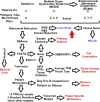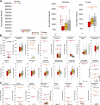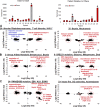Virus-induced genetics revealed by multidimensional precision medicine transcriptional workflow applicable to COVID-19
- PMID: 32437232
- PMCID: PMC7303726
- DOI: 10.1152/physiolgenomics.00045.2020
Virus-induced genetics revealed by multidimensional precision medicine transcriptional workflow applicable to COVID-19
Abstract
Precision medicine requires the translation of basic biological understanding to medical insights, mainly applied to characterization of each unique patient. In many clinical settings, this requires tools that can be broadly used to identify pathology and risks. Patients often present to the intensive care unit with broad phenotypes, including multiple organ dysfunction syndrome (MODS) resulting from infection, trauma, or other disease processes. Etiology and outcomes are unique to individuals, making it difficult to cohort patients with MODS, but presenting a prime target for testing/developing tools for precision medicine. Using multitime point whole blood (cellular/acellular) total transcriptomics in 27 patients, we highlight the promise of simultaneously mapping viral/bacterial load, cell composition, tissue damage biomarkers, balance between syndromic biology versus environmental response, and unique biological insights in each patient using a single platform measurement. Integration of a transcriptome workflow yielded unexpected insights into the complex interplay between host genetics and viral/bacterial specific mechanisms, highlighted by a unique case of virally induced genetics (VIG) within one of these 27 patients. The power of RNA-Seq to study unique patient biology while investigating environmental contributions can be a critical tool moving forward for translational sciences applied to precision medicine.
Keywords: PICU; RNAseq; multiple organ dysfunction syndrome; precision medicine; transcriptomics.
Conflict of interest statement
No conflicts of interest, financial or otherwise, are declared by the authors.
Figures








References
-
- Ajogbasile FV, Oguzie JU, Oluniyi PE, Eromon PE, Uwanibe JN, Mehta SB, Siddle KJ, Odia I, Winnicki SM, Akpede N, Akpede G, Okogbenin S, Ogbaini-Emovon E, MacInnis BL, Folarin OA, Modjarrad K, Schaffner SF, Tomori O, Ihekweazu C, Sabeti PC, Happi CT. Real-time Metagenomic Analysis of Undiagnosed Fever Cases Unveils a Yellow Fever Outbreak in Edo State, Nigeria. Sci Rep 10: 3180, 2020. doi: 10.1038/s41598-020-59880-w. - DOI - PMC - PubMed
-
- Almansa R, Heredia-Rodríguez M, Gomez-Sanchez E, Andaluz-Ojeda D, Iglesias V, Rico L, Ortega A, Gomez-Pesquera E, Liu P, Aragón M, Eiros JM, Jiménez-Sousa MÁ, Resino S, Gómez-Herreras I, Bermejo-Martín JF, Tamayo E. Transcriptomic correlates of organ failure extent in sepsis. J Infect 70: 445–456, 2015. doi: 10.1016/j.jinf.2014.12.010. - DOI - PubMed
-
- Almansa R, Socias L, Sanchez-Garcia M, Martín-Loeches I, del Olmo M, Andaluz-Ojeda D, Bobillo F, Rico L, Herrero A, Roig V, San-Jose CA, Rosich S, Barbado J, Disdier C, de Lejarazu RO, Gallegos MC, Fernandez V, Bermejo-Martin JF. Critical COPD respiratory illness is linked to increased transcriptomic activity of neutrophil proteases genes. BMC Res Notes 5: 401, 2012. doi: 10.1186/1756-0500-5-401. - DOI - PMC - PubMed
-
- Arulkumaran N, Singer M. Multiple Organ Dysfunction, in Critical Care Nephrology (Ronco C, Bellomo R, Kellum JA, Ricci Z, editors). (3rd ed.). Elsevier, chapt. 37, p. 205–208.e2, 2019.
Publication types
MeSH terms
Grants and funding
LinkOut - more resources
Full Text Sources

